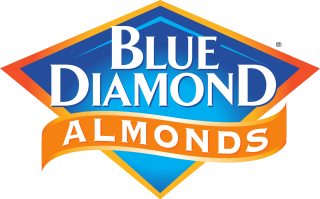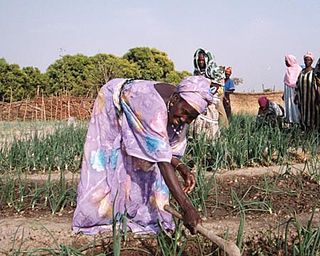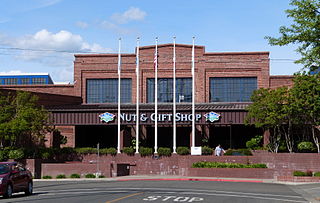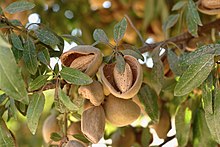
The almond is a species of tree from the genus Prunus. Along with the peach, it is classified in the subgenus Amygdalus, distinguished from the other subgenera by corrugations on the shell (endocarp) surrounding the seed.

Almond milk is a plant-based milk substitute with a watery texture and nutty flavor manufactured from almonds, although some types or brands are flavored in imitation of cow's milk. It does not contain cholesterol or lactose and is low in saturated fat. Almond milk is often consumed by those who are lactose-intolerant and others, such as vegans, who avoid dairy products. Commercial almond milk comes in sweetened, unsweetened, vanilla and chocolate flavors, and is usually fortified with micronutrients. It can also be made at home using a blender, almonds and water.

The Highland Park Ford Plant is a historic former Ford Motor Company factory located at 91 Manchester Street in Highland Park, Michigan. It was Ford's third factory, it was the second American Model T production facility and it was the first factory in history to assemble automobiles on a moving assembly line. Highland Park became a National Historic Landmark in 1978.

Sunkist Growers, Incorporated, branded as Sunkist, is an American citrus growers' non-stock membership cooperative composed of over 1,000 members from California and Arizona headquartered in Valencia, California. Through 31 offices in the United States and Canada and four offices outside North America, its sales in 1991 totaled $956 million. It is the largest fresh produce shipper in the United States, the most diversified citrus processing and marketing operation in the world, and one of California's largest landowners.

Blue Diamond Growers is an agricultural cooperative and marketing organization that specializes in California almonds. Founded in 1910 as the California Almond Growers' Exchange, the organization claims to be the world's largest tree nut processing and marketing company. It serves 3,500 almond growers, and helps make the almond crop California's largest food export.

An agricultural cooperative, also known as a farmers' co-op, is a producer cooperative in which farmers pool their resources in certain areas of activities.

Diamond Foods was an American packaged food company based in San Francisco, that marketed nuts and other snack foods. Diamond Foods was acquired by Snyder's-Lance in 2016, and as of 2018, Campbell Soup Company owns Diamond Foods's former snack brands; Diamond of California, Diamond Foods's nut business, is owned by Blue Road Capital.
Yamato Colony, California was a Japanese agricultural community in Livingston, California, United States. The Japanese farmers were instrumental in founding the Livingston Farmers Association.

HP Hood LLC is an American dairy company based in Lynnfield, Massachusetts. Hood was founded in 1846 in Derry, New Hampshire, by Harvey Perley Hood. After two years in Derry, Hood took his milk south and established a factory in Charlestown, Massachusetts. Recent company acquisitions by HP Hood have expanded its reach from predominantly New England to the broader United States. Today, the company has an annual sales revenue of about $3.2 billion and more than 3,400 employees.

Maraba coffee is grown in the Maraba area of southern Rwanda. Maraba's coffee plants are the Bourbon variety of the Coffea arabica species and are grown on fertile volcanic soils on high-altitude hills. The fruit is handpicked, mostly during the rainy season between March and May, and brought to a washing station in Maraba, where the coffee beans are extracted and dried. At several stages, the beans are sorted according to quality. The farmers receive credits based on the amount and quality of the beans they provide.

The Boston Flower Exchange is a wholesale flower market located in Boston, Massachusetts. Founded as a marketplace that local growers could rent cooperatively to sell their products in a space more suited to their needs than Boston's historic Haymarket open-air marketplace, it has been the focal point of the floral trade of New England for over a hundred years. Although originally a local growers' wholesale market, the Flower Exchange now features flowers and foliage from dozens of countries and has expanded to carry potted plants, glassware, pottery and other floral supplies. The Flower Exchange is not open to the public and is limited to members of the trade only.

Wilco is a farmer-owned farm supply cooperative that began as the Santiam Farmers Co-op in the 1930s based in the Willamette Valley of the U.S. state of Oregon. In 1967, the Santiam Farmers Co-op merged with 4 other co-ops, the Mt. Angel Farmers Union Warehouse, the Donald Farmers Co-op, the Valley Farmers Co-op in Silverton, and the Canby Cooperative to form "Wilco Farmers Coop". The name "Wilco" comes from a shortening of "Willamette Consolidated".

The Diamond Match Company is a brand of matches and toothpicks, and formerly other wood products and plastic cutlery, that has its roots in a business started in 1853 by Edward Tatnall in Wilmington, Delaware. Ownership passed to William H. Swift and Henry Courtney who operated under the name Swift & Courtney and marketed their product as Diamond State Parlor Matches.

The Calpak Plant No. 11 in Sacramento, California, is a building built in 1925. Calpak constructed the building as a fruit cannery but it is now used by Blue Diamond Almonds It was listed on the National Register of Historic Places in 1984.

Select Harvests is Australia's largest almond grower and processor, and is the third largest grower worldwide. It manages almond orchards in Victoria, New South Wales and South Australia, and is also involved in the manufacture of a variety of food snacks and muesli. The company, based in Melbourne, employs around 270 permanently, which peaks up to 500 people seasonally (2015).

American Crystal Sugar Company is an agricultural cooperative specializing in the production of sugar and related agri-products. American Crystal is owned by nearly 2,800 shareholders who raise approximately one-third of the nation's sugarbeet acreage in the Red River valley of Minnesota and North Dakota. As the largest beet sugar producer in the United States, the company utilizes innovative farming practices, low-cost production methods, and sales and marketing leadership to produce and sell about 15 percent of America's sugar. American Crystal operates sugar factories in Crookston, East Grand Forks, and Moorhead Minnesota; Drayton and Hillsboro, North Dakota. The company's technical services center and corporate headquarters are also located in Moorhead.

Royal FloraHolland, legally Koninklijke Coöperatieve Bloemenveiling Royal FloraHolland U.A., is a Dutch conglomerate of florists. It is one of the largest auction companies in the world. Royal FloraHolland is headquartered in Aalsmeer, with locations in Naaldwijk, Rijnsburg and Eelde.

California produces 80% of the world's almonds and 100% of the United States commercial supply. Although almonds are not native to California, a hot, dry Mediterranean climate and developed water infrastructure create favorable conditions for commercial cultivation of the crop. In 2020, there were 1.25 million acres (5,100 km2) devoted to almond farming in California, producing 2.8 billion pounds (1.3 Mt).
Sacramento, California, United States, has been an important location in the history of canning thanks to its situation on the intersection of major transportation routes and proximity to large fertile growing areas. Sacramento’s canning industry has prepared a large variety of agricultural products, but is best known for canned tomatoes, earning Sacramento the nickname, "The Big Tomato."





















